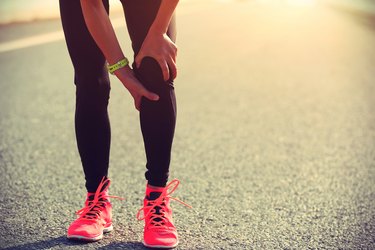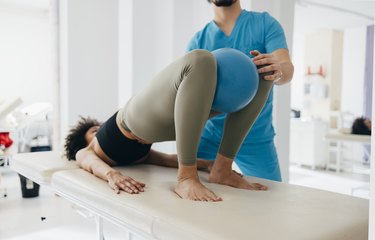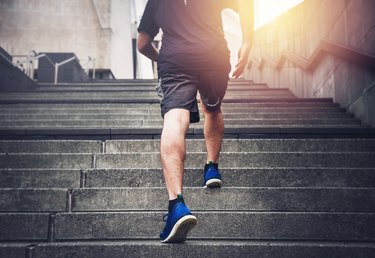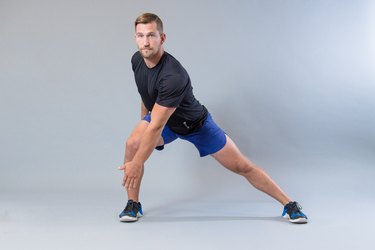

It's an athlete's greatest fear: You're training consistently each week, moving closer and closer to your personal goals. The pain in your knee begins as a little itch but becomes more difficult to ignore with each workout you finish. Before long, you're in the doctor's office because your knee hurts every time you straighten your leg.
Unfortunately, knee pain is a common issue among all kinds of athletes and gym-goers and can happen through either overuse or direct trauma. Whether your knee pain is dull or sharp, or it hurts when you bend and straighten it, consult a doctor before continuing your training schedule.
Video of the Day
Video of the Day
Frequently Asked Questions
- What is the most common cause of knee pain? Most often, knee pain is caused by overexerting your knee before it's ready, according to Tyler Nightingale, DPT.
- Should I be worried about pain behind the knee? A little stiffness after a hard workout is probably no cause for concern but consistent or sharp pain can indicate an injury or other condition (more on that below). In that case, it's best to talk to a doctor.
- What does a torn ligament behind the knee feel like? Although pain levels vary depending on the type of tear, generally, torn ligaments cause sudden and severe pain. You may hear a loud snap or pop at the time of injury, too.
Causes of Knee Pain When Straightening Your Leg
Knee pain can come from a variety of direct causes, whether it's sprinting downhill or even kicking a ball. However, the most common cause of knee pain is usually doing "too much too soon," Nightingale says. A rapid increase in activity or repetitive performance of a new movement can result in tissue overload, causing swelling or pain.
If you're feeling pain while straightening the knee (knee extension), it's probably due to cartilage or joint surface damage between your larger leg bones (the femur and tibia), Nightingale says. When you extend your knee, contact between these bones increases and can cause painful pressure. This damage is usually the result of an injury.
Below, we'll break down the most common injuries that cause chronic knee pain when straightening the leg, which can be categorized as either overuse injuries or traumatic injuries.
3 Common Knee Overuse Injuries
1. Runner's Knee
Tendons are strong bands of fibrous tissue that connect muscle to bone. Pain in the patellar tendon (patellofemoral pain syndrome) — which attaches the bottom of the kneecap to the top of the shinbone — is common.
It can occur from repetitive knee movements, especially jumping and climbing stairs, according to the American Academy of Orthopaedic Surgeons (AAOS).
A common form of this syndrome is runner's knee, which is caused by overuse of the tendons through the repetitive motion of running. The best way to prevent runner's knee? Strengthening the supporting muscles around your knee (including your hamstrings, quads and glutes) and varying your activities as much as possible.
2. Muscle Imbalance
Overuse knee pain can also be caused by a muscular imbalance in the quadriceps muscles, according to the AAOS.
When your knee bends, it relies on your quad muscles and quadriceps tendon to keep the kneecap within the trochlear groove (think of this as the pathway the knee should follow). If your quads are weak or imbalanced, that might cause the knee to track abnormally through this groove, resulting in pain.
The severity of the pain determines the best treatment method for either injury, but it is typically advised to begin knee pain treatment with the RICE method, according to the AAOS. RICE stands for rest, ice, compression and elevation.
However, if pain persists after you've iced your knee several times a day, rested properly and have taken other precautions, it's a good idea to visit your doctor. He or she will most likely recommend physical therapy or orthotics if the pain can be treated non-surgically.
3. Knee Arthritis
Knee arthritis happens when the cartilage in your knees starts to wear down, causing your knee to feel stiff and painful when you move or stretch your knee, according to Johns Hopkins Medicine. Unfortunately, this cartilage loss can't be fixed or reversed.
There are a few different types of knee arthritis, all with their own causes, too.
- Osteoarthritis of the knee: Osteoarthritis is often caused by age-related wear and tear in your joints. This type of knee arthritis can often lead to painful inflammation in your knee.
- Rheumatoid arthritis of the knee: This is an autoimmune disease, which causes your immune system to attack the healthy joints in your body. The high levels of inflammation resulting from rheumatoid arthritis cause your knee cartilage to break down over time.
- Post-traumatic knee arthritis: Trauma to the knee (more on that below) can cause arthritis due to the loss of knee stability and the breakdown of cartilage over time.
Unfortunately, there's one sure way to prevent knee arthritis. But you can modify your activities to help decrease your pain levels. Avoid high-impact activities (like jumping), which can cause more inflammation in your knees. You can also work with a physical therapist to help improve your knee's range of motion and overall strength.
3 Common Traumatic Knee Injuries
1. Meniscus Tear
One common form of traumatic knee injury is a meniscus tear. Each knee contains two small pieces of rubbery cartilage called menisci located deep within the joint, according to the AAOS. Your menisci act as shock absorbers between the two main bones of the knee — the femur (or thighbone) and the tibia (or shinbone).
Meniscus tears are common injuries that typically result from exercise or other physical activity. Sometimes this injury can feel like a "pop" in the knee and cause stiffness when straightening. Knee swelling may occur, especially with tears caused by an acute injury. And part of the torn meniscus sometimes catches between the bones, causing locking of the knee.
In some cases, meniscus tears can be accompanied by a Baker cyst, according to the Mayo Clinic. This is a small sac of fluid that can appear on the back of your knee as a result of a torn meniscus. In some cases, these cysts can be totally painless but they can cause additional pain on the back of your knee.
If you have a meniscus tear, your doctor may recommend that you pause your physical activities and spend plenty of time resting and icing your knee. In some cases, surgery may be required but this isn't too common.
2. ACL Tear
Tears of the anterior cruciate ligament (ACL) are another traumatic knee injury that may be the source of pain while straightening the knee, according to Nightingale.
Often, these injuries are sustained by athletes who play high-intensity sports like soccer, football or basketball where the player rapidly changes direction, stops and starts frequently or experiences direct collision, according to the AAOS.
An ACL tear may require surgery, according to the AAOS. Typically, a surgeon must rebuild the ligament and stitch it back together in order to restore stability to the knee.
Treating an ACL tear depends on the severity of the injury, per the AAOS. Before you try any treatment method, consult your doctor. For younger athletes, a medical professional may recommend a surgical procedure, while others may be able to return to a typical, low-activity lifestyle without any surgery. Treatments vary case by case, so it's crucial to get a professional opinion.
After surgery, patients typically follow a physical therapy program to help regain strength and motion of the knee before returning to any physical activities.
3. PCL Tear
A posterior cruciate ligament (PCL) tear is another common injury that may cause pain in the back of your knee when you straighten your leg, according to Manhattan Orthopedic Care. Posterior knee pain can happen when you overstrain and tear the ligaments in the back of your knee, often from quick changes in direction (as in a lot of sports).
Like with ACL tears, PCL injuries usually require the help of a physician, so if you feel any sharp pain in the back of your knee when you straighten it, it's best to consult your doctor. You may also develop a Baker's cyst along with your PCL tear (more on that above), which can cause additional discomfort.
Generally, doctors recommend ice, rest and potentially a splint to treat PCL tears. But before you try any at-home treatments, ask your doctor what they recommend.
When to See a Doctor
If you are experiencing sharp, shooting or throbbing knee pain that prevents you from putting full weight onto your leg, it's best to see your doctor right away, Nightingale says — especially if you sustained the injury traumatically through a fall or collision.
Symptoms like locking or catching of the knee are also common signs of a more serious injury and a red flag that you should consult a doctor ASAP. Also consult the help of a professional if your knee hurts when you bend and straighten it, as this may signal a more serious injury, like an ACL or meniscus tear.
Any chronic knee pain lasting more than a few days should be assessed as well.
Decode Your Knee Pain
To figure out what's causing your knee pain, it can be helpful to think through a few things: type and intensity, onset, location and activities.
- Type and Intensity: Is the pain sharp? Dull? Throbbing? Sharp pain, as well as anything that's intense enough to change the way you move or do daily activities, is cause to talk to your doctor.
- Onset: Did the pain come on all of the sudden, or has it gradually been getting worse over time? Sudden knee pain is usually a sign of an acute injury, whereas slowly developing pain tends to be due to overuse.
- Location: The more centralized your pain is to the joint itself — rather than the surrounding muscles — the more likely you're dealing with an injury as opposed to a muscle ache. Pay attention to if it's in your kneecap or the back of your knee and pass on that info to your doctor or physical therapist.
- Activities: Do you feel knee pain every time you straighten your knee? Or just when climbing the stairs or running? Narrow down the exact activities that worsen the pain and try to avoid them as you recover.
Relieve Your Knee Pain
- AAOS: "Patellofemoral Pain Syndrome"
- AAOS: "Meniscus Tears"
- AAOS: "Anterior Cruciate Ligament (ACL) Injuries"
- Manhattan Orthopedic Care: "What is Causing Your Pain Behind the Knee – Posterior Knee Pain?"
- Mayo Clinic: "Baker Cyst"
- Johns Hopkins Medicine: "Knee Arthritis"
- Indian Journal of Radiology and Imaging: Bursae Around the Knee Joints
- American Academy of Orthopedic Surgeons: Patellar (Kneecap) Fractures
- American Academy of Orthopedic Surgeons: Fractures of the Proximal Tibia (Shinbone)


